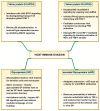Immunological Perspective for Ebola Virus Infection and Various Treatment Measures Taken to Fight the Disease
- PMID: 33080902
- PMCID: PMC7603231
- DOI: 10.3390/pathogens9100850
Immunological Perspective for Ebola Virus Infection and Various Treatment Measures Taken to Fight the Disease
Abstract
Ebolaviruses, discovered in 1976, belongs to the Filoviridae family, which also includes Marburg and Lloviu viruses. They are negative-stranded RNA viruses with six known species identified to date. Ebola virus (EBOV) is a member of Zaire ebolavirus species and can cause the Ebola virus disease (EVD), an emerging zoonotic disease that results in homeostatic imbalance and multi-organ failure. There are three EBOV outbreaks documented in the last six years resulting in significant morbidity (> 32,000 cases) and mortality (> 13,500 deaths). The potential factors contributing to the high infectivity of this virus include multiple entry mechanisms, susceptibility of the host cells, employment of multiple immune evasion mechanisms and rapid person-to-person transmission. EBOV infection leads to cytokine storm, disseminated intravascular coagulation, host T cell apoptosis as well as cell mediated and humoral immune response. In this review, a concise recap of cell types targeted by EBOV and EVD symptoms followed by detailed run-through of host innate and adaptive immune responses, virus-driven regulation and their combined effects contributing to the disease pathogenesis has been presented. At last, the vaccine and drug development initiatives as well as challenges related to the management of infection have been discussed.
Keywords: Ebola vaccines; T-cell immunity; bystander apoptosis; cytokines response; host immune evasion.
Conflict of interest statement
The authors declare no conflict of interest
Figures


Similar articles
-
Transcriptional Analysis of Lymphoid Tissues from Infected Nonhuman Primates Reveals the Basis for Attenuation and Immunogenicity of an Ebola Virus Encoding a Mutant VP35 Protein.J Virol. 2021 Feb 24;95(6):e01995-20. doi: 10.1128/JVI.01995-20. Print 2021 Feb 24. J Virol. 2021. PMID: 33408171 Free PMC article.
-
Dendritic Cells Generated From Mops condylurus, a Likely Filovirus Reservoir Host, Are Susceptible to and Activated by Zaire Ebolavirus Infection.Front Immunol. 2019 Oct 11;10:2414. doi: 10.3389/fimmu.2019.02414. eCollection 2019. Front Immunol. 2019. PMID: 31681302 Free PMC article.
-
Antiviral Innate Responses Induced by VSV-EBOV Vaccination Contribute to Rapid Protection.mBio. 2019 May 28;10(3):e00597-19. doi: 10.1128/mBio.00597-19. mBio. 2019. PMID: 31138743 Free PMC article.
-
To B or Not to B: Mechanisms of Protection Conferred by rVSV-EBOV-GP and the Roles of Innate and Adaptive Immunity.Microorganisms. 2020 Sep 25;8(10):1473. doi: 10.3390/microorganisms8101473. Microorganisms. 2020. PMID: 32992829 Free PMC article. Review.
-
Ebola vaccine trials: progress in vaccine safety and immunogenicity.Expert Rev Vaccines. 2019 Dec;18(12):1229-1242. doi: 10.1080/14760584.2019.1698952. Expert Rev Vaccines. 2019. PMID: 31779496 Review.
Cited by
-
Epidemiology of Ebolaviruses from an Etiological Perspective.Pathogens. 2023 Feb 3;12(2):248. doi: 10.3390/pathogens12020248. Pathogens. 2023. PMID: 36839520 Free PMC article. Review.
-
Structural and Functional Aspects of Ebola Virus Proteins.Pathogens. 2021 Oct 15;10(10):1330. doi: 10.3390/pathogens10101330. Pathogens. 2021. PMID: 34684279 Free PMC article. Review.
-
How to prepare for the next inevitable Ebola outbreak: lessons from West Africa.Nat Med. 2024 Dec;30(12):3413-3416. doi: 10.1038/s41591-024-03295-x. Nat Med. 2024. PMID: 39420216 No abstract available.
-
Immune correlates of protection for SARS-CoV-2, Ebola and Nipah virus infection.Front Immunol. 2023 Apr 17;14:1156758. doi: 10.3389/fimmu.2023.1156758. eCollection 2023. Front Immunol. 2023. PMID: 37153606 Free PMC article. Review.
-
RNA Viruses, Pregnancy and Vaccination: Emerging Lessons from COVID-19 and Ebola Virus Disease.Pathogens. 2022 Jul 15;11(7):800. doi: 10.3390/pathogens11070800. Pathogens. 2022. PMID: 35890044 Free PMC article. Review.
References
Publication types
LinkOut - more resources
Full Text Sources

